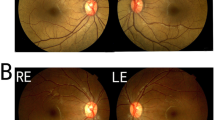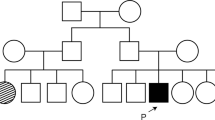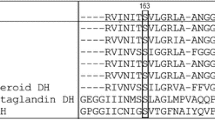Abstract
Purpose
We report a 15-month follow-up case on a Chinese patient with Oguchi disease associated with the multiple evanescent white dot syndrome (MEWDS).
Methods
The patient’s clinical presentation and follow-up visits were documented via decimal best-corrected visual acuity, fundus photography, fundus autofluorescence (FAF) imaging, near-infrared FAF, spectral domain optical coherence tomography, Humphrey’s visual fields, microperimetry, and multifocal electroretinography. We also performed whole exome sequencing for screening variation in the patient and her relatives.
Results
The patient had typical clinical characteristic of Oguchi disease, including night blindness, the Mizuo–Nakamura phenomenon (a golden yellow discoloration of the fundus that disappears in the prolonged dark adaptation [DA]) and typical full-field electroretinogram changes (nearly undetected b-wave in 0.01 and 0.03 ERGs that can partially recover only after prolonged DA). Aside from Oguchi disease, the patient was also diagnosed with the MEWDS based on clinical detections, including suddenly reduced visual acuity, appeared white dots, blurred ellipsoid zone and disrupted interdigitation zone, enlarged blind spot, and reduced macular sensitivity. A series of investigations revealed that along with the 15-month follow-up after onset, the visual acuity enhanced, the numerous white dots disappeared, and the macular structure returned to normal. Moreover, the novel homozygous splicing alteration c.181 + 1G > A was identified in the SAG gene.
Conclusions
This work is the first long-term case study of a patient with Oguchi disease associated with the MEWDS. The recovery period of symptoms caused by the MEWDS was much longer than that in typical patients with MEWDS. Molecular genetics demonstrate that this is the first case of Oguchi disease caused by splicing alterations in the SAG gene.





Similar content being viewed by others
References
Fuchs S, Nakazawa M, Maw M, Tamai M, Oguchi Y, Gal A (1995) A homozygous 1-base pair deletion in the arrestin gene is a frequent cause of Oguchi disease in Japanese. Nat Genet 10(3):360
Miyake Y, Horiguchi M, Suzuki S, Kondo M, Tanikawa A (1996) Electrophysiological findings in patients with Oguchi’s disease. Jpn J Ophthalmol 40(4):511–519
Godara P, Cooper RF, Sergouniotis PI, Diederichs MA, Streb MR, Genead MA et al (2012) Assessing retinal structure in complete congenital stationary night blindness and Oguchi disease. Am J Ophthalmol 154(6):987-1001.e1
Yamamoto S, Sippel KC, Berson EL, Dryja TP (1997) Defects in the rhodopsin kinase gene in the Oguchi form of stationary night blindness. Nat Genet 15(2):175
dell’Omo R, Pavesio CE (2012) Multiple evanescent white dot syndrome (MEWDS). Int Ophthalmol Clin 52(4):221–228
Brydak-Godowska J, Golebiewska J, Turczynska M, Moneta-Wielgos J, Samsel A, Borkowski PK et al (2017) Observation and clinical pattern in patients with white dot syndromes: the role of color photography in monitoring ocular changes in long-term observation. Med Sci Monit: Int Med J Exp Clin Res 23:1106–1115
McCulloch DL, Marmor MF, Brigell MG, Hamilton R, Holder GE, Tzekov R et al (2015) ISCEV Standard for full-field clinical electroretinography (2015 update). Doc Ophthalmol 130(1):1–12
Hood DC, Bach M, Brigell M, Keating D, Kondo M, Lyons JS et al (2012) ISCEV standard for clinical multifocal electroretinography (mfERG) (2011 edition). Doc Ophthalmol 124(1):1–13
Sergouniotis PI, Davidson AE, Sehmi K, Webster AR, Robson AG, Moore AT (2011) Mizuo–Nakamura phenomenon in Oguchi disease due to a homozygous nonsense mutation in the SAG gene. Eye (London, England). 25(8):1098–1101
Nishiguchi KM, Ikeda Y, Fujita K, Kunikata H, Akiho M, Hashimoto K et al (2019) Phenotypic features of Oguchi disease and retinitis pigmentosa in patients with S-antigen mutations: a long-term follow-up study. Ophthalmology 126:1557–1566
Yuan A, Nusinowitz S, Sarraf D (2011) Mizuo-Nakamura phenomenon with a negative waveform ERG. Br J Ophthalmol 95(1):147–148
Agarwal R, Tripathy K, Bandyopadhyay G, Basu K (2019) Mizuo–Nakamura phenomenon in an Indian male. Clin Case Rep 7(2):401–403
Colombo L, Abeshi A, Maltese PE, Frecer V, Miertus J, Cerra D et al (2018) Oguchi type I caused by a homozygous missense variation in the SAG gene. Eur J Med Genet 62:103548
Huang L, Li W, Tang W, Zhu X, Ou-Yang P, Lu G (2012) A Chinese family with Oguchi’s disease due to compound heterozygosity including a novel deletion in the arrestin gene. Mol Vis 18:528–536
Kuroda M, Hirami Y, Nishida A, Jin ZB, Ishigami C, Takahashi M et al (2011) A case of Oguchi disease with disappearance of golden tapetal-like fundus reflex after vitreous resection. Nippon Ganka Gakkai Zasshi 115(10):916–923
Fujinami K, Tsunoda K, Nakamura M, Oguchi Y, Miyake Y (2011) Oguchi disease with unusual findings associated with a heterozygous mutation in the SAG gene. Arch Ophthalmol (Chicago, IL: 1960) 129(10):1375–1376
Maw M, Kumaramanickavel G, Kar B, John S, Bridges R, Denton M (1998) Two Indian siblings with Oguchi disease are homozygous for an arrestin mutation encoding premature termination. Hum Mutat 50(Suppl 1):S317–S319
Hayashi T, Tsuzuranuki S, Kozaki K, Urashima M, Tsuneoka H (2011) Macular dysfunction in Oguchi disease with the frequent mutation 1147delA in the SAG gene. Ophthalmic Res 46(4):175–180
Zhang Q, Zulfiqar F, Riazuddin SA, Xiao X, Yasmeen A, Rogan PK et al (2005) A variant form of Oguchi disease mapped to 13q34 associated with partial deletion of GRK1 gene. Mol Vis 11:977–985
Jampol LM, Sieving PA, Pugh D, Fishman GA, Gilbert H (1984) Multiple evanescent white dot syndrome: I. Clinical findings. Arch Ophthalmol 102(5):671–674
Cahuzac A, Wolff B, Mathis T, Errera MH, Sahel JA, Mauget-Faysse M (2017) Multimodal imaging findings in ‘hyper-early’ stage MEWDS. Br J Ophthalmol 101(10):1381–1385
Furino C, Boscia F, Cardascia N, Alessio G, Sborgia C (2009) Fundus autofluorescence and multiple evanescent white dot syndrome. Retina 29(1):60–63
Margolis R, Mukkamala SK, Jampol LM, Spaide RF, Ober MD, Sorenson JA et al (2011) The expanded spectrum of focal choroidal excavation. Arch Ophthalmol 129(10):1320–1325
Mantovani A, Invernizzi A, Staurenghi G, Herbort CP Jr (2019) Multiple evanescent white dot syndrome: a multimodal imaging study of foveal granularity. Ocular Immunol Inflamm 27(1):141–147
Hashimoto Y, Saito W, Hasegawa Y, Noda K, Ishida S (2019) Involvement of inner choroidal layer in choroidal thinning during regression of multiple evanescent white dot syndrome. J Ophthalmol 2019:6816925
Yang JS, Chen CL, Hu YZ, Zeng R (2018) Multiple evanescent white dot syndrome following rabies vaccination: a case report. BMC Ophthalmol 18(1):312
Yang CS, Wang AG, Lin YH, Huang YM, Lee FL, Lee SM (2012) Optical coherence tomography in resolution of photoreceptor damage in multiple evanescent white dot syndrome. J Chin Med Assoc: JCMA 75(12):663–666
Marsiglia M, Gallego-Pinazo R, De Souza EC, Munk MR, Yu S, Mrejen S et al (2016) Expanded clinical spectrum of multiple evanescent white dot syndrome with multimodal imaging. Retina 36(1):64–74
Li D, Kishi S (2009) Restored photoreceptor outer segment damage in multiple evanescent white dot syndrome. Ophthalmology 116(4):762–770
Jampol LM, Becker KG (2003) White spot syndromes of the retina: a hypothesis based on the common genetic hypothesis of autoimmune/inflammatory disease. Am J Ophthalmol 135(3):376–379
Gass JD (2003) Are acute zonal occult outer retinopathy and the white sopt syndromes (AZOOR complex) specific autoimmune diseases? Am J Ophthalmol 135:380–381
Yamada T, Matsumoto M, Kadoi C, Nagaki Y, Hayasaka Y, Hayasaka S, Hayasaka S (1999) 1147 del A mutation in the arrestin gene in Japanese patients with Oguchi disease. Ophthalmic Genet 20(2):117–120
Nakamachi Y, Nakamura M, Fujii S, Yamamoto M, Okubo K (1998) Oguchi disease with sectoral retinitis pigmentosa harboring adenine deletion at position 1147 in the arrestin gene. Am J Ophthalmol 125(2):249–251
Nakazawa M, Wada Y, Fuchs S, Gal A, Tamai M (1997) Oguchi disease: phenotypic characteristics of patients with the frequent 1147delA mutation in the arrestin gene. Retina (Philadelphia, PA) 17(1):17–22
Waheed NK, Qavi AH, Malik SN, Maria M, Riaz M, Cremers FP et al (2012) A nonsense mutation in S-antigen (p.Glu306*) causes Oguchi disease. Mol Vis 18:1253–1259
Acknowledgements
Kaoru Fujinami is a paid consultant of Astellas Pharma Inc, Kubota Pharmaceutical Holdings Co., Ltd, and Acucela Inc. Kaoru Fujinami reports personal fees from Astellas Pharma Inc, personal fees from Kubota Pharmaceutical Holdings Co., Ltd., personal fees from Acucela Inc., personal fees from SANTEN Company Limited, personal fees from Foundation Fighting Blindness, personal fees from Foundation Fighting Blindness Clinical Research Institute, personal fees from Japanese Ophthalmology Society, personal fees from Japan Retinitis Pigmentosa Society. Kaoru Fujinami reports grants from Astellas Pharma Inc (NCT03281005), outside the submitted work.
Author information
Authors and Affiliations
Contributions
Shiying Li is supported by grants from the National Nature Science Foundation of China (81974138), Third Military Medical University (Army Medical University) research grant (2017XYY02), and National Basic Research Program of China (2018YFA0107301). Gang Wang is supported by grants from the Third Military Medical University, Southwest Hospital Innovation Grant (SWH2015LC15). Kaoru Fujinami is supported by grants from Grant-in-Aid for Young Scientists (A) of the Ministry of Education, Culture, Sports, Science and Technology, Japan (16H06269), grants from Grant-in-Aid for Scientists to support international collaborative studies of the Ministry of Education, Culture, Sports, Science and Technology, Japan (16KK01930002), grants from National Hospital Organization Network Research Fund (H30-NHO-2-12), grants from the Foundation for Fighting Blindness–Alan Laties Career Development Program (CF-CL-0416-0696-UCL), grants from Health Labor Sciences Research Grant, The Ministry of Health, Labor and Welfare (201711107A), and grants from the Great Britain Sasakawa Foundation Butterfield Awards.
Corresponding authors
Ethics declarations
Conflict of interest
All authors have completed the COI Form for Disclosure of Potential Conflicts of Interest. Individual investigators who participate in the sponsored project(s) are not directly compensated by the sponsor but may receive a salary or other support from the institution to support their effort on the project(s).
Statements of human rights
The procedures used were approved by the local ethics committee of Southwest Eye Hospital, Third Military Medical University (Army Medical University), Chongqing, China (reference number: 73981486-2), and all procedures were performed in accordance with the Declaration of Helsinki.
Informed consent
The patient and her relatives, who were also studied upon, gave informed consent for all procedures described involved in the study.
Statement on the welfare of animals
All the experimental procedures were performed in accordance with institutional animal welfare guidelines, were approved by the Third Military Medical University Animal Care and Use Committee
Additional information
Publisher's Note
Springer Nature remains neutral with regard to jurisdictional claims in published maps and institutional affiliations.
Rights and permissions
About this article
Cite this article
Liu, X., Gao, L., Wang, G. et al. Oguchi disease caused by a homozygous novel SAG splicing alteration associated with the multiple evanescent white dot syndrome: A 15-month follow-up. Doc Ophthalmol 141, 217–226 (2020). https://doi.org/10.1007/s10633-020-09766-z
Received:
Accepted:
Published:
Issue Date:
DOI: https://doi.org/10.1007/s10633-020-09766-z




